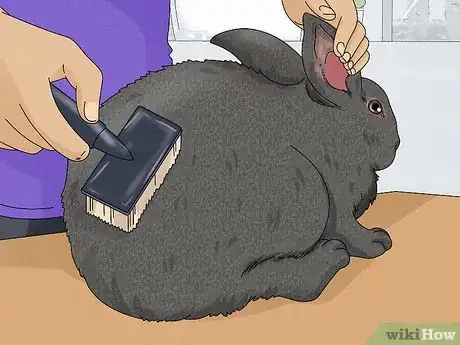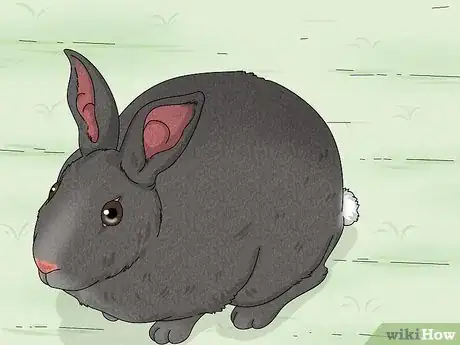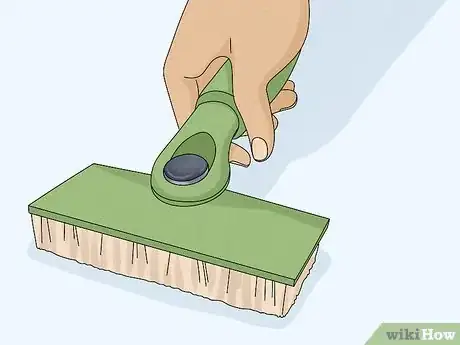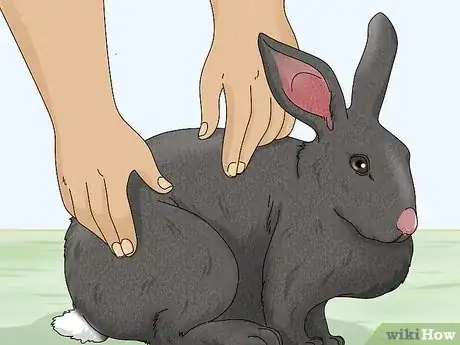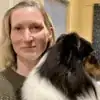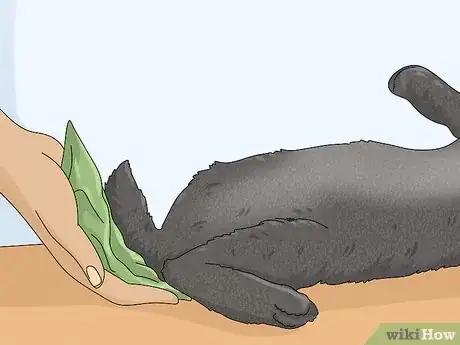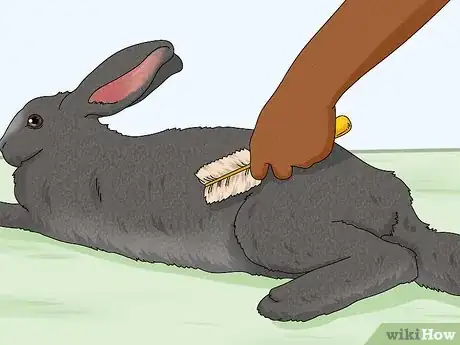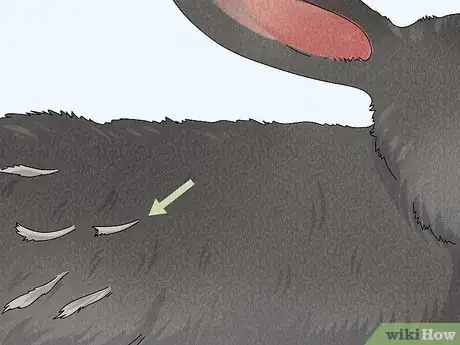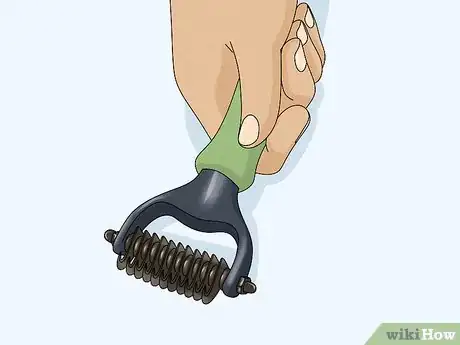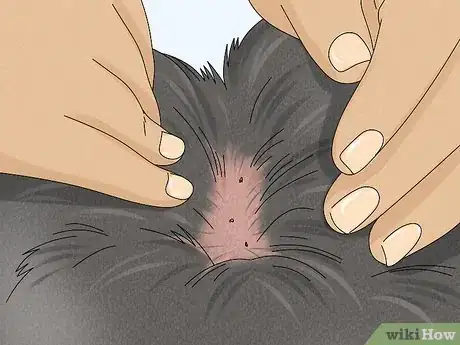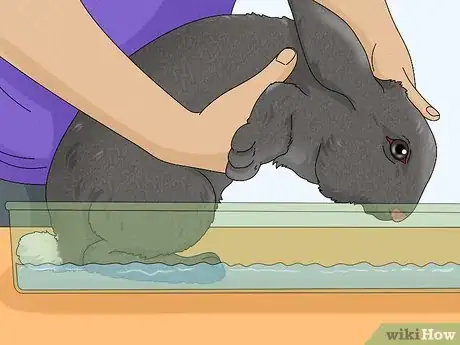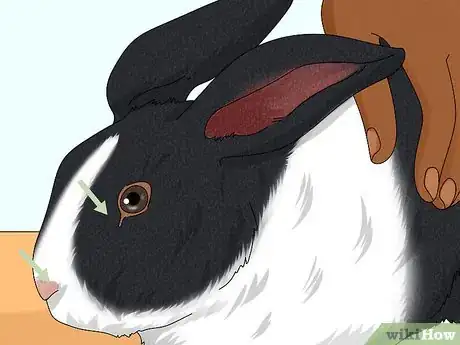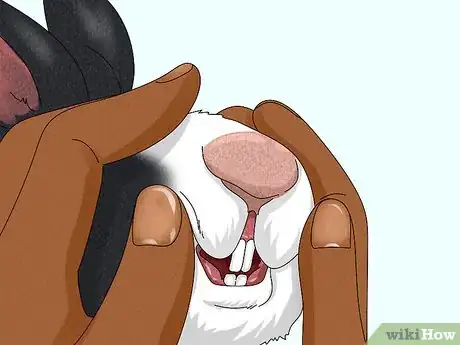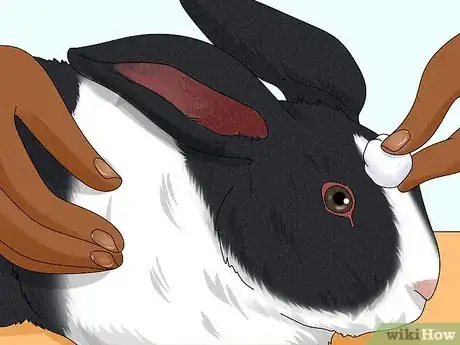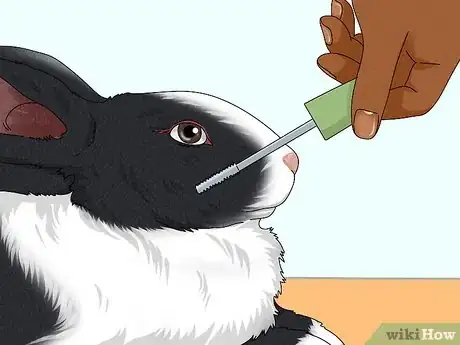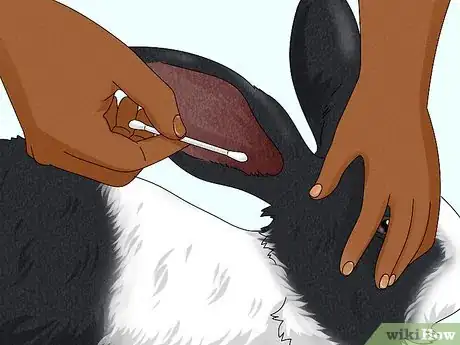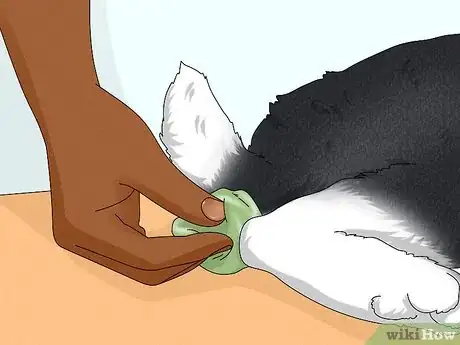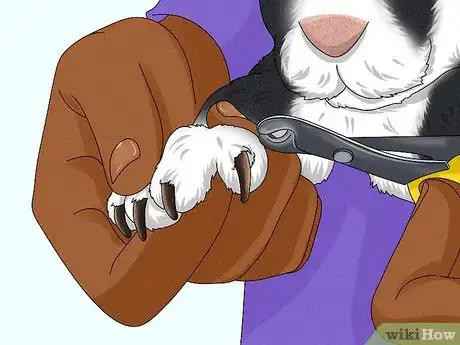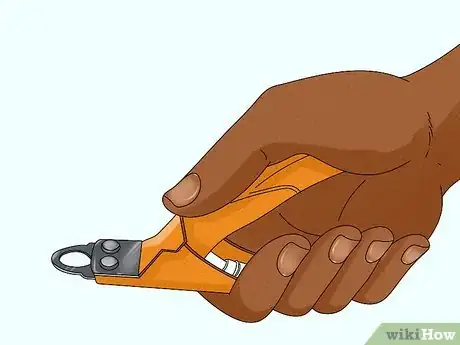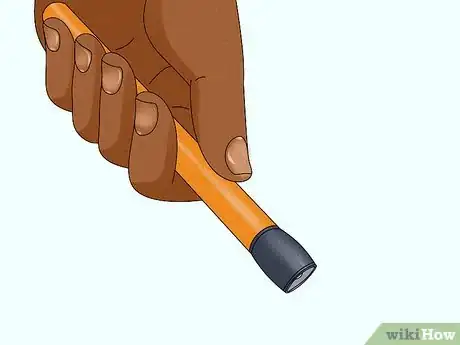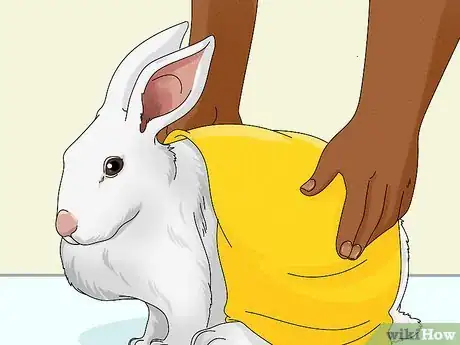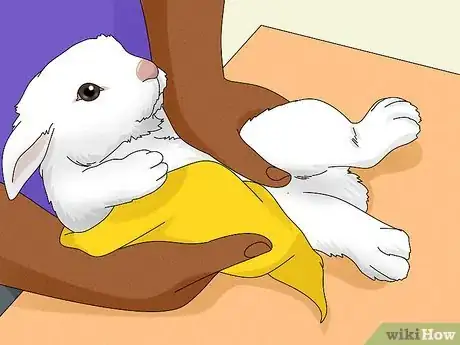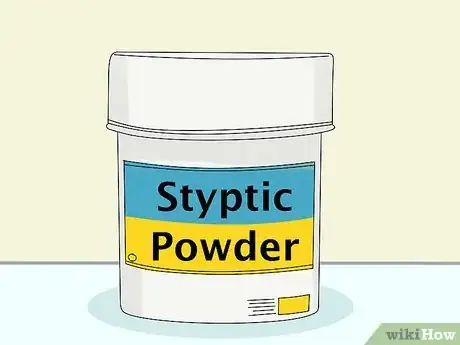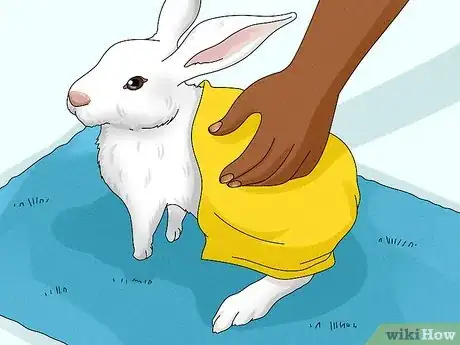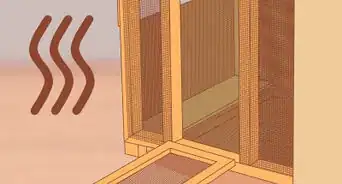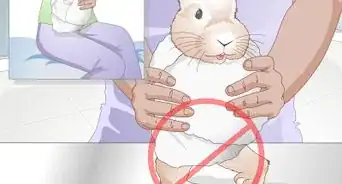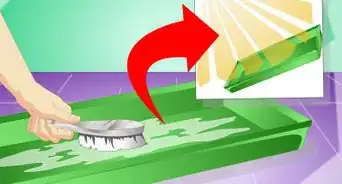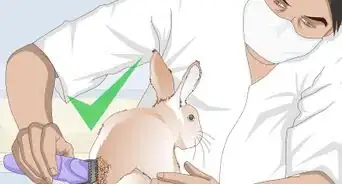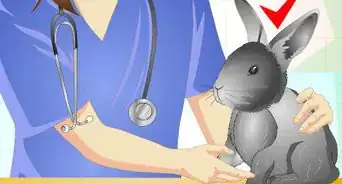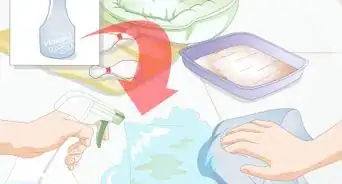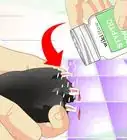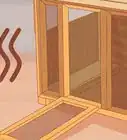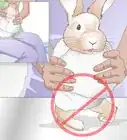This article was co-authored by Jamie Freyer, DVM and by wikiHow staff writer, Amy Bobinger. Dr. Jamie Freyer is a Licensed Doctor of Veterinary Medicine based in Washington. With over ten years of experience in clinical practice and industry, she specializes in veterinary medicine and surgery, animal behavior, and animal genetics. Dr. Freyer holds a BS in Life Science from The University of Portland and a DVM from Oregon State University.
There are 16 references cited in this article, which can be found at the bottom of the page.
This article has been viewed 138,443 times.
Is there anything cuter than a soft, fluffy-tailed rabbit? Bunnies are social animals, and they can make great pets as long as you go into it knowing that they require a lot of care. Although they spend a lot of their time grooming themselves, your rabbit will also need some help from you to keep it healthy and clean.
Steps
Brushing Your Rabbit's Fur
-
1Brush your rabbit every 3-7 days. Rabbits groom themselves frequently, but they still need help from you. If you don't brush them regularly, they can ingest too much hair, which can lead to serious health problems.[1] To prevent this, most rabbits need to be brushed about every 3 days or so. If you have a long-haired rabbit, you might need to brush it even more often, while you may be able to brush short-haired rabbits about once a week.[2]
- If your rabbit's poops are linked together, chances are it's ingesting too much hair. Try brushing it more often.
- If you don't see much loose hair after grooming your rabbit, you're probably okay to wait a little longer between brushing sessions.
-
2Groom your rabbit daily when it's shedding heavily. Rabbits shed their fur about once every 3 months—and every other shed is typically a very heavy one where they lose most of their coat. When this is happening, brush your rabbit at least once a day, if not more often. Otherwise, you'll have a lot of hair everywhere, and your rabbit will get sick from trying to groom away all that extra fur.[3]
- Depending on the rabbit, its shed might happen all in one day, over a period of several days, or even over a few weeks.
- It's common for rabbits to develop some bald spots while they're shedding. Don't worry too much if you see this, as long as the spots aren't flaky and don't seem to bother your rabbit. Ask your vet if you're not sure, though.[4]
Advertisement -
3Use a soft brush made for cats or rabbits. Since rabbits have sensitive skin, some of them really hate being brushed, especially if you use a stiff brush. It can take some trial and error to find the type of brush that makes your rabbit most comfortable, but soft cat brushes tend to work well.[5] Other options include:
- Flea comb
- Rubber brush[6]
- Fine-tooth comb made for people
- Glove brush
-
4Massage your rabbit to calm them before you start brushing. Don't try to brush your rabbit when it's excited or scared—that's just going to make it more anxious about being groomed in the future. Instead, take a few minutes to pet it calmly before you start grooming, making sure your rabbit is settled and comfortable.[7]
- Most rabbits will be most comfortable if you groom them on the floor, but if your rabbit doesn't mind being handled, you can put it on your lap.[8]
-
5Start by wiping your rabbit's bottom with a damp cloth. Sometimes urine or droppings can get stuck in your rabbit's fur. If you don't clean this, it can irritate your rabbit's skin, so take a moment to wipe its underside with a damp cloth or cotton pad before you start brushing.[9]
- This will also make sure you don't accidentally spread urine or feces while you're brushing your rabbit's fur.
- If your rabbit is overweight, it might especially have a hard time keeping its bottom clean.
-
6Begin gently brushing in the direction of your rabbit's fur. Pet your rabbit with one hand to keep it calm and hold it in place.[10] At the same time, use your other hand to very gently stroke the brush or comb across your rabbit's fur. Don't press down too hard or you could irritate your rabbit's thin, sensitive skin.[11]
- If you're using a comb, hold it sideways so it's almost parallel to your rabbit's skin. [12]
- Brush in the direction that your rabbit's fur grows—most rabbits won't like it if you brush the other way.
- To keep your rabbit calm, start by brushing the top of its head and its back. Once your rabbit has had a few grooming sessions, gradually move down to brushing its lower face and chin.[13]
-
7Remove any loose tufts that you see. As you brush your rabbit, you'll probably see tufts of fur starting to form. Keep petting the rabbit with your free hand and use the hand that's holding the brush to pluck these tufts loose. Your rabbit usually won't mind that you're doing this as long as you're gentle.[14]
- You can also use a glove brush or a rubber brush to help you collect these tufts.
-
8Remove mats with a fur splitter and a friend. If you notice any mats or clumps in your rabbit's fur, ask someone to help you—it can be a little tough to keep your rabbit still while you comb these out. Have the other person hold the rabbit steady while you use a fur splitter to gently separate and remove the mats.[15]
- A fur splitter is a specialized wide-tooth comb that allows you to tease the mats out of your rabbit's fur without yanking.
- Mats often form on the pads of a rabbit's feet, so remember to check there, as well.[16]
- If the matted fur is too clumped to comb, it's best to take your rabbit to your vet or a professional groomer. If you're comfortable using animal clippers, you can shave away the mats, but be very careful, because it's very easy to tear or cut your rabbit's skin.
- Don't use scissors to remove the mats from your rabbit's fur, as it's very easy to accidentally cut them.
-
9Check for parasites as you brush your bunny. Look carefully at your rabbit's skin and fur as you groom it, keeping an eye out for things like mites, fleas, or ticks. Also, check for flaky skin or bald patches, which could be signs of parasites. Parasites can make your rabbit very uncomfortable or even sick, so if you do notice any of these, call your vet right away and ask them about treatment options.[17]
- Fleas are tiny black insects, and you'll tend to notice them around your bunny's head or groin area.
- Ticks are larger, round insects, and you might see them crawling in your bunny's fur or attached to their skin.
- Mites will look like dandruff. Also check for dark debris in your bunny's ear, which could be a sign of ear mites.
-
10Spot-bathe your bunny if its fur is soiled. Rabbits generally don't need to be bathed, but occasionally, their fur may get soiled with urine or feces. If that happens, dip only the rabbit's bottom in warm water and use your hand to cleanse the area. Then, towel-dry your rabbit thoroughly, or use a blow dryer set to warm (not hot) to dry their fur.[18]
- Don't ever put a rabbit completely in water—it could lead to shock.
- You can also give your rabbit a dry bath. To do that, sprinkle a little cornstarch onto the area that needs to be cleaned and massage it into your rabbit's fur. Then, comb the cornstarch out of the fur and use a cloth to wipe away any excess.[19]
Face and Scent Gland Care
-
1Check your rabbit's eyes and nose anytime you brush it. Grooming is the perfect time to examine your bunny to make sure it doesn't have any health problems going on. Check whether it has any discharge coming from its eyes or nose.[20] Also, make sure its eyes aren't crusty, cloudy, or irritated. If you notice anything, call your vet.[21]
- Also, feel around its jaw to make sure it doesn't have any lumps or abscesses.
-
2Examine its teeth at each grooming as well. While you're doing that, look at the rabbit's front teeth to make sure they don't look overgrown or chipped. Also, check its gums to make sure they're pink—not red or purple, which could be a sign of inflammation.[22]
- In addition, make sure your rabbit isn't drooling and doesn't have a bad odor coming from its mouth. These could be signs of a problem with its back teeth.
-
3Wipe away any residue around its eyes with a moist cotton ball. Your bunny might sometimes have a little gunk around its eyes—as long as it's not crusty and its eyes aren't watering, this is normal and doesn't mean there's a problem. However, to keep the area around your rabbit's eyes from getting irritated, wipe the area with a damp cotton ball any time you see any moisture or buildup there.[23]
- Only wipe the area around your rabbit's eyes—never touch its eyeball.
- This will also remove any hay that might get into the rabbit's eyes.
-
4Brush any fur out of your rabbit's eyes with a mascara brush. If your rabbit has long hair, it can grow down into its eyes, which can lead to irritation. Check for this when you're examining your rabbit's eyes. If you notice any hair over its eyes, use a small spoolie to smooth back the hair around your bunny's eyes each time you brush your rabbit. You can also use a small flea comb.[24]
- If brushing the hair doesn't help, use a small pair of scissors to carefully trim it out of the way.
-
5Wipe ear wax from the outer ear with a cotton swab during grooming. Each time you groom your rabbit, carefully wipe any waxy buildup out of your bunny's ear, but be careful to always swipe outward. Don't push down, or it could push wax further into the ear canal. Also, never try to remove wax from deep in the ear canal.
- If your bunny has wax buildup deep in their ear, ask your vet to recommend an ear wash solution, and talk to them about the safest way to use it. However, this is best done under a vet's supervision.[25]
-
6Clean your rabbit's scent glands with mineral oil when necessary. Look for the two slits on either side of your rabbit's genitals—these are its scent glands. Dip a cotton ball or cotton swab in some mineral oil and gently swipe it onto these glands. That will soften the waxy buildup there so you can carefully wipe it away with a clean cotton ball or swab.[26]
- Bunnies have glands near their anus that release their scent. These glands can become clogged, so if you notice a bad odor coming from your rabbit, it's a good idea to clean their scent glands.
- These glands are made of a very sensitive membrane, so be extremely gentle when you do this, or the membrane could tear.[27]
Clipping a Rabbit's Nails
-
1Clip your rabbit's nails every 1-2 months. Rabbit's nails grow continuously, and if you don't clip them, your bunny could accidentally scratch you. It also becomes uncomfortable for your rabbit when its nails get too long, so keep an eye on them, and trim them anytime they start growing long.[28]
- If you're not comfortable trimming your bunny's nails yourself, take them to your vet for a trimming.[29]
-
2Use a guillotine-style nail clipper. This might be a scary-sounding name, but don't worry—it's the same basic type of nail clipper that's used for cats and birds. These are the perfect size for trimming your bunny's nails, too! You can pick one up at any pet store.[30]
- If you have a baby bunny, it's easiest to just file its nails with an emery board until it gets big enough for this type of clipper.[31]
-
3Use a penlight to see the quick if your rabbit has dark nails. Just like cats and dogs, rabbits have a blood supply that runs a certain length down their nails. This is called the quick, and it can be hard to see if your rabbit has dark-colored nails. To make the quick easier to see, hold a penlight behind the claw—don't trim into the area that looks darker in the light.[32]
- It's pretty easy to see the quick if your rabbit has light-colored nails, so don't worry about using a light.
-
4Wrap the back half of your bunny in a towel to trim its front paws. It can be pretty hard to hold a wiggly rabbit still while you trim its nails. To make this easier, wrap your rabbit's back legs in a towel, but leave its front paws free. Then, simply hold one front paw at a time while you clip its nails.
- It's a good idea to have one person cradle the rabbit in the towel while the other person holds the clippers.[33]
- If your rabbit is super calm, you might not even need the towel. Just hold the bunny at the edge of a table so it's cradled against your body. This will help it feel secure as you trim its front paws.[34]
- Be patient—the rabbit will likely try to pull its paws back as you do this. Pet the rabbit to keep it calm, and take a break if it starts to panic.
-
5Hold the bunny upright to trim its back claws. Securely hold your rabbit with one hand on its chest, then lift it up so it's standing on its hind legs. Keep the bunny pressed against you, then use your free hand to trim the nails on its back paws.[35]
- Some people find that it's actually easier to trim the back paws.
- It can help to have someone else hold the bunny upright as you clip.
-
6Apply styptic powder to the nail if you trim too far. If you do accidentally cut into the quick, don't panic. Take a little styptic powder between your thumb and forefinger and press it into the nail. Hold a finger over the powder for about 1 minute, applying steady pressure. The bleeding should stop, and the styptic powder will also help numb any pain the rabbit is feeling.[36]
- You can also use flour or cornstarch if you don't have styptic powder on hand.[37]
- If the bleeding doesn't stop after about 10 minutes, call your vet.
-
7Place soft rugs in your rabbit's enclosure if the fur on its feet wears down. When you're clipping your bunny's nails, take a good look at its feet. If the padding, or fur, is worn down, it can lead to serious irritation. To help avoid that, use soft resting pads, or rugs, in your bunny's habitat or the floor of its enclosure.[38]
Expert Q&A
-
QuestionHow do you calm a rabbit for grooming?
 Jamie Freyer, DVMDr. Jamie Freyer is a Licensed Doctor of Veterinary Medicine based in Washington. With over ten years of experience in clinical practice and industry, she specializes in veterinary medicine and surgery, animal behavior, and animal genetics. Dr. Freyer holds a BS in Life Science from The University of Portland and a DVM from Oregon State University.
Jamie Freyer, DVMDr. Jamie Freyer is a Licensed Doctor of Veterinary Medicine based in Washington. With over ten years of experience in clinical practice and industry, she specializes in veterinary medicine and surgery, animal behavior, and animal genetics. Dr. Freyer holds a BS in Life Science from The University of Portland and a DVM from Oregon State University.
Licensed Veterinarian There's a technique called trancing. It is not something you should attempt on your own at first, though. If possible, have a professional show you how to do it first. Basically, you put the bunny upside down on your lap and you cover its eyes or pet its head.
There's a technique called trancing. It is not something you should attempt on your own at first, though. If possible, have a professional show you how to do it first. Basically, you put the bunny upside down on your lap and you cover its eyes or pet its head.
Warnings
- When you're clipping your rabbit's claws, take care not to clip into the quick. This is painful for the rabbit and can cause bleeding.⧼thumbs_response⧽
- Do not try to clean inside your rabbit's inner ear canal. If it has waxy buildup deep in the ear, ask your vet about an ear cleaning solution.⧼thumbs_response⧽
- Do not lay your rabbit on its back—this can lead to trancing, which is stressful and dangerous for your rabbit.[42]⧼thumbs_response⧽
References
- ↑ https://therabbithaven.org/rabbit-grooming-basics
- ↑ https://bunnylady.com/rabbit-grooming/
- ↑ https://rabbit.org/faq-grooming/
- ↑ https://resources.bestfriends.org/article/rabbit-grooming-how-groom-shedding-bunny
- ↑ https://resources.bestfriends.org/article/rabbit-grooming-how-groom-shedding-bunny
- ↑ https://bunnylady.com/rabbit-grooming/
- ↑ https://bunnylady.com/rabbit-grooming/
- ↑ Jamie Freyer, DVM. Licensed Veterinarian. Expert Interview. 7 December 2021.
- ↑ https://www.rabbitcaretips.com/rabbit-grooming-behavior/
- ↑ Jamie Freyer, DVM. Licensed Veterinarian. Expert Interview. 7 December 2021.
- ↑ https://resources.bestfriends.org/article/rabbit-grooming-how-groom-shedding-bunny
- ↑ https://bunnylady.com/rabbit-grooming/
- ↑ https://www.wihumane.org/behavior/ask-the-experts/rabbit-behavior/grooming-your-rabbit
- ↑ https://bunnylady.com/rabbit-grooming/
- ↑ https://bunnylady.com/rabbit-grooming/
- ↑ https://therabbithaven.org/rabbit-grooming-basics
- ↑ https://therabbithaven.org/rabbit-grooming-basics
- ↑ https://resources.bestfriends.org/article/rabbit-grooming-how-groom-shedding-bunny
- ↑ https://bunnylady.com/rabbit-grooming/
- ↑ https://resources.bestfriends.org/article/rabbit-grooming-how-groom-shedding-bunny
- ↑ https://bunnylady.com/rabbit-grooming/
- ↑ https://bunnylady.com/rabbit-grooming/
- ↑ https://therabbithaven.org/rabbit-grooming-basics
- ↑ https://therabbithaven.org/rabbit-grooming-basics
- ↑ https://therabbithaven.org/rabbit-grooming-basics
- ↑ https://www.awanj.org/wp-content/uploads/Rabbit-Handout-06-Grooming-Your-Rabbit.pdf
- ↑ https://therabbithaven.org/rabbit-grooming-basics
- ↑ https://bunnylady.com/rabbit-grooming/
- ↑ Jamie Freyer, DVM. Licensed Veterinarian. Expert Interview. 7 December 2021.
- ↑ https://resources.bestfriends.org/article/rabbit-grooming-how-groom-shedding-bunny
- ↑ https://therabbithaven.org/rabbit-grooming-basics
- ↑ https://therabbithaven.org/rabbit-grooming-basics
- ↑ https://resources.bestfriends.org/article/rabbit-grooming-how-groom-shedding-bunny
- ↑ https://bunnylady.com/rabbit-grooming/
- ↑ https://bunnylady.com/rabbit-grooming/
- ↑ https://therabbithaven.org/rabbit-grooming-basics
- ↑ https://bunnylady.com/rabbit-grooming/
- ↑ https://www.awanj.org/wp-content/uploads/Rabbit-Handout-06-Grooming-Your-Rabbit.pdf
- ↑ https://therabbithaven.org/rabbit-grooming-basics
- ↑ https://therabbithaven.org/rabbit-grooming-basics
- ↑ https://rabbit.org/faq-grooming/
- ↑ https://rabbitwelfare.co.uk/rabbit-care-advice/maintenance-handling/trancing/
